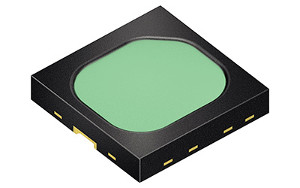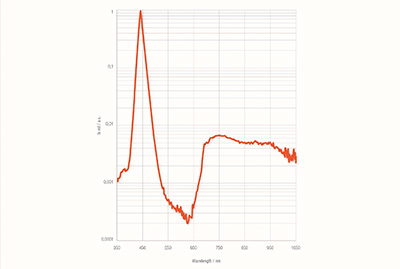 |
| November 15, 2016 | Volume 12 Issue 43 |
Designfax weekly eMagazine
Archives
Partners
Manufacturing Center
Product Spotlight
Modern Applications News
Metalworking Ideas For
Today's Job Shops
Tooling and Production
Strategies for large
metalworking plants
Osram debuts world's first broadband infrared LED
A new LED emitter from Osram Opto Semiconductors paves the way for everyday food analytics. Just point and shoot with your cell phone, and one day soon you may be able to determine the freshness of a tomato or the amount of calories in that double-scoop ice cream cone.

Osram Opto Semiconductors has introduced the SFH 4735, the first broadband infrared LED. The main application is near-infrared spectroscopy (for example, in analyzing food). [Image: Osram]
Osram is utilizing converter technology for infrared emitters for the first time to produce an LED that emits broadband infrared light in a wavelength range from 650 to 1,050 nanometers (nm).
The main application is near-infrared spectroscopy, such as analyzing food to measure fat, protein, water, or sugar content.
This broadband infrared LED, the SFH 4735, is based on a blue chip and a special phosphor converter. The LED component is ideally suited for near-infrared spectroscopy for analyzing food quality.
It's a first for the industry. The broadband-emitting infrared LED enables this specific sensor technology to move into the consumer sector, for example, as an add-on for smartphones. The first mini spectrometers have already been showcased, and the new LED means that a compact light source is now available.
Infrared spectroscopy uses the characteristic absorption behavior of certain molecular compounds. If a defined spectrum is directed at a sample, it is possible to determine the presence and quantity of certain ingredients from the wavelength distribution of the reflected light. This method is used in the food industry and in agriculture (among other sectors) to measure, for example, the water, fat, carbohydrate, sugar, or protein content of foodstuffs. This data provides an indication of freshness, quality, or calorie content.

The first broadband infrared LED from Osram Opto Semiconductors will make near-infrared spectrometry for mobile devices a reality. Measuring the fat, protein, water, or sugar content in food is one everyday application. [Image: Osram]
The Osram infrared LED opens this measurement technique up for the consumer market. One option is a compact sensor, like a USB stick, that would be used with an appropriate smartphone app to measure calories, freshness, or nutritional content.
Experts expect that it will be possible in the near future to integrate such spectrometers directly in mobile devices. The new technology is a natural extension of bio monitoring, in other words, the trend for measuring various vital signs such as pulse rate and calorie consumption. A smartphone spectrometer will enable users to monitor the food they eat in a similar manner.
Medicines can also be checked and/or identified in the same way -- a particularly useful feature if you find, for example, loose pills in the kitchen junk drawer at your aging parents' house.
"It is conceivable that the emission range can be extended to include wavelengths up to 2,000 nanometers, which is the middle infrared spectral range," says Chris Goeltner, product marketing manager for infrared at Osram. "This will allow more precise and detailed measurements and will open up new options for everyday analyses of certain environmental parameters such as air quality."

The first broadband infrared LED from Osram Opto Semiconductors emits in a wavelength range from 650 to 1,050 nm. The SFH 4735 is based on a blue chip and a special phosphor converter. [Image: Osram]
The basis of the SFH 4735 is a blue 1-mm2 chip in UX:3 technology. Its light is converted into infrared radiation with the aid of a phosphor converter developed specifically for this application. A residual blue component in the light helps users target the area they want to investigate.
The emission spectrum of the SFH 4735 has a homogeneous spectral distribution in the infrared range. The chip is mounted in the compact and performance-proven Oslon Black Flat package, which is characterized by excellent thermal resistance.
Source: Osram Opto Semiconductors
Published November 2016
Rate this article
View our terms of use and privacy policy
